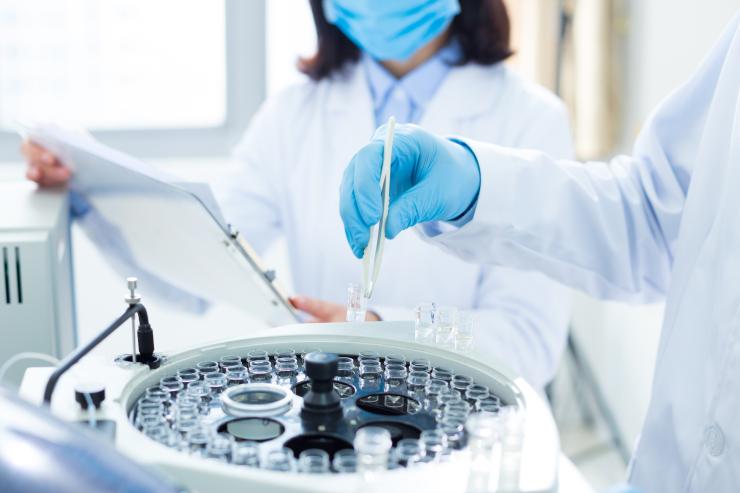
Overview: The Alkek Center for Metagenomics and Microbiome Research (CMMR) is an Academic Center at Baylor College of Medicine (BCM), located within the Texas Medical Center (TMC), a nearly 1,000-acre complex, housing 59 member institutions. The CMMR was established in 2011 by Dr. Joseph Petrosino in the Department of Molecular Virology and Microbiology at Baylor College of Medicine. The Mission of the CMMR is to serve as an international hub for the development and implementation of advanced technologies for the understanding of how the microbiome impacts health and disease, and for the translation of this knowledge into microbiome-based therapeutics and diagnostics.
Facilities: The CMMR operates in a roughly 6,000 sq. ft. area on the second floor of Dynamic One within TMC III Helix Park containing 60 workbenches, 16 workstations, 7 individual offices, 4 shared offices, and 1 conference room with teleconferencing capabilities.
2500 sq. ft. of the spaces listed above are BSL-2 laboratories with restricted access containing 4 biosafety cabinets. The labs were built with partitioned areas for 1) sample intake and nucleic acid extraction, 2) pre-PCR, and 3) post-PCR and sequencing, as well as a unidirectional sample path from extraction through DNA sequencing.
In addition to the space listed above, the CMMR has access to a five-suite clinical laboratory with additional check-in and prep stations as needed. The space is outfitted per standard clinical IRB guidelines, has restricted access, and was used as one of the Human Microbiome Project clinical sampling laboratories. Dr. Wendy Keitel, of our department and director of the BCM-Vaccine Treatment and Evaluation Unit, is the physician in charge of the space. An eight suite BSL-3 Enhanced facility is also available. BCM also has a large vivarium, and mouse genotyping core, for applicable projects.
Laboratory Equipment: Within the laboratories, each workbench consists of two or more workstations, with laboratory setups that include a full range of pipettes (P2 – P1000), vortex, mini centrifuge. The laboratories also have two dedicated large equipment rooms for shakers, incubators, and centrifuges. Cold storage requirements are met with large refrigerators, a 4°C cold room, eleven -20°C freezers, and eighteen -80°C freezers. We have the ability to culture bacteria under a variety of environmental conditions with five cell culture hoods, two CO2 incubators, a Thermo Heratherm, and a VWR Symphony. Bacterial cultures are visualized with one of the following microscopes: two Nikons, two Zeiss and an Olympus BX61 inverted fluorescent microscope. For centrifugation, we have the following instruments: Thermo XR4-Pro, two Thermo XPro, two Thermo Sorvall ST8, and a Thermo Heraeus Multifuge X1R. Protein purification is carried out on a GE FPLC.
The lab is well equipped for conducting high throughput metagenomic and microbiome studies.
Sample Intake: For sample receiving and tracking, the lab employs Thermo Scientific Vision Mate readers in addition to Zebra handheld scanners at various stations throughout the pipeline.
Nucleic Acid Extraction: The CMMR operates multiple automated platforms for nucleic acid extraction including two Qiagen QIAcube Connect systems, two Qiagen QIAcube HT systems, and two Integra VIAFLO 96 systems. We have extensive experience handling numerous sample types from human, animal and environmental sources. Our workhorse extraction kits include Qiagen PowerSoil Pro, Qiagen PowerMicrobiome, Qiagen DNeasy 96 Blood & Tissue, Qiagen QIAamp DNA FFPE, among others. While somewhat sample type and kit dependent, automated nucleic acid extraction within the CMMR proceeds at a rate of up to 800 samples per day.
Sequencing Library and PCR Preparation: Extracted nucleic acids undergo sequencing library preparation and PCR setup using both automated and manual platforms. The CMMR utilizes Illumina DNA Prep, KAPA Hyper & Twist EF 2.0 kits for NGS sequencing library preparations. Manual fragmentation is carried out on the Covaris LE220 plus. Automation of associated PCR and library steps is handled by Hamilton STARlet and Integra VIAFLO 96 platforms. Manual manipulations are carried out in one of 3 available PCR enclosures. Library preparations and other PCR reactions proceed on one of 8 thermocyclers (one ABI Veriti and seven Eppendorf Mastercycler x50s machines). Within the CMMR, we can generate up to 1000 amplicon libraries per day and up to 300 WGS libraries per day.
Nucleic Acid Quantification: Resulting extracts and libraries are quantified with a number of different available instruments including a Nanodrop spectrophotometer, PicoGreen and a Thermo Fisher Qubit 4/Flex fluorometers for individual sample analysis. High throughput Quant-iT PicoGreen assays, DNA normalization, and DNA pooling are automated using the Hamilton STARlet and Integra VIAFLO 96 platforms. Resulting assays are read utilizing the Thermo Fluoroskan microplate reader. DNA fragment size analysis is performed using an Agilent Fragment Analyzer 5200, Agilent Fragment Analyzer 5300, or Agilent TapeStation 4150. DNA is size selected on a Sage Biosciences Blue Pippin. Library and PCR QC in the CMMR proceeds at a rate of up to 800 samples per day.
Sequencing: Resulting libraries are sequenced on one of a number of different platforms that include: Illumina iSeq100, MiSeq, NextSeq1000, and NovaSeq 6000 machines. Most recently we have acquired multiple Oxford Nanopore Technologies MinION machines.
Computational Overview: CMMR at BCM maintains a high-performance computing cluster (HPCC) to address the growing computational analysis goals of the center. Initial deployment occurred in the summer of 2014. An updated infrastructure was deployed in 2025 to meet current and emerging computational workloads in metagenomic research and analysis.
The CMMR HPCC utilizes 12 Intel-based, 64-bit compute nodes under batch management and accessible via redundant login nodes. The primary compute nodes comprise 10 high-performance nodes with 320 total physical compute cores (Intel "Emerald Rapids") with large onboard cache and 1 TB memory each. Two dedicated GPU (Tesla G4-based) nodes serve GPU-optimized or ML-developmental computing needs. The login nodes serve as portals into the CMMR HPCC environment to keep it segregated from the BCM network. In addition, each login node provides an interactive environment for development, data review, and batch job submission. All nodes run Red Hat Enterprise Linux.
The storage system serving the CMMR HPCC utilizes a multi-tiered, high-performance storage solution managed by PixStor Ngenea. Each compute node is connected via a 100-Gbit interconnect to a quarter-petabyte of purely NVMe-based primary storage as well as 1.2 PB of secondary, conventional storage.
The entire CMMR HPCC is housed in a secure facility inside a limited-access, interior room at the building core with a dedicated UPS, independent cooling and constant remote monitoring. The space is flexibly designed to be scalable to accommodate additional compute resources as research needs dictate.








